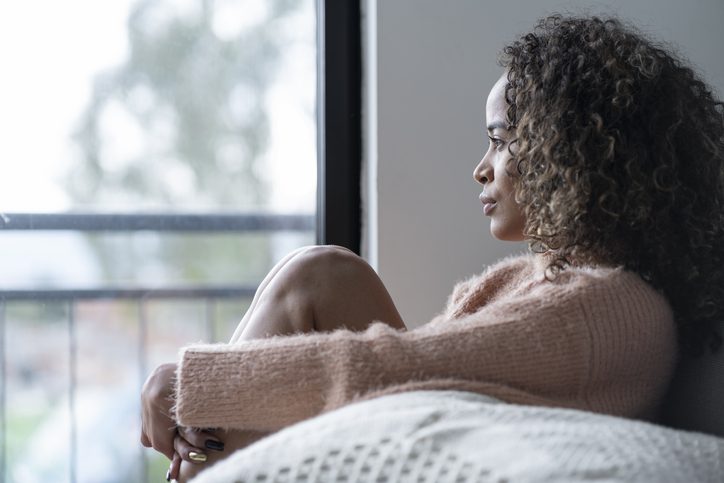“I’ll Just Stay Home”: When Social Anxiety Becomes A Problem
According to the Pew Research Center, about 35% of Americans say that social interaction has decreased in importance for them since the COVID-19 pandemic. Another study suggests that social anxiety has increased since the pandemic. Whether the 35% of Americans who now prefer to stay home do so because of social anxiety is unclear.
So is this a problem? When does choosing to socialize less become a matter of concern?
Social anxiety disorder (also called social phobia) is defined by the American Psychological Association (APA) as “fear of social situations in which embarrassment may occur (e.g., making conversation, meeting strangers, dating) or there is a risk of being negatively evaluated by others (e.g., seen as stupid, weak, or anxious).”
Most of us feel nervous now and then about how we present ourselves or about what others may think of us. But social anxiety disorder takes this nervousness to a very high level, such that it causes significant distress and makes it difficult to function in the world.
What Social Anxiety Disorder Looks Like
Social anxiety generally arises in three arenas: interaction, observation and performance. Anxiety related to interaction will arise when the person meets new people, has to talk in front of a group, or has to talk to an authority figure (a boss/supervisor, for example). Anxiety around observation happens whenever a person feels watched (when eating, when walking down the street, when shopping, etc.). And performance anxiety does not just mean performing on a stage or public speaking – it can also mean cooking a meal in front of someone, signing one’s name in front of others, or performing any simple demonstration for others.
Other signs of social anxiety disorder include:
- Fear that others will notice that you look anxious
- Fear of showing physical indications of anxiety, like blushing, sweating, trembling, or talking in a shaky voice
- Avoidance of doing things or speaking to people
- Avoidance of situations where you might be the center of attention
- Intense self-criticism, analyzing your “flaws” after a social situation
- Expecting the worst possible outcome after having a negative social interaction
Social Anxiety Disorder in Children and Teens
Children who show signs of social anxiety disorder are often called “shy,” as if their fears are temporary and kind of cute. While most “shy” children do grow bolder and more confident with time, some continue to struggle with social fears throughout their childhood and teenage years. These anxieties can be excruciating and debilitating. School is often the hotbed of social anxiety for children, where answering a question or being called on in class, eating in the cafeteria, getting to class on time, finding time to use the bathroom, etc., can cause so much distress that the child or teen dreads going to school and opts out of any extracurricular activities.
The signs of social anxiety in children, especially young children, may be different than those in adults. Children may cry or throw tantrums in response to social situations, or refuse to speak to or make eye contact with others. When children or teens frequently get sick, it may be related to anxiety about having to go to school or another event. But the classic signs of anxiety apply as well: blushing, sweating, rapid heartbeat, nausea, dizziness, and more.
Social anxiety in children and teens becomes a problem worth seeking help for when it keeps them from participating in activities they might otherwise enjoy. While it can be easy for parents to just let a child stay at home, this will only make the anxiety worse over time.
The Dangers of Untreated Social Anxiety Disorder
To sum up, letting social anxiety disorder in adults or children go untreated can lead to serious quality-of-life and mental health issues:
- Avoidance of people and social events
- Missed opportunities
- Loneliness and boredom
- Depression, potentially severe
- Low self-esteem
- Substance abuse and addiction
- Suicide
Treatment for Social Anxiety Disorder
If you or your child or loved one are suffering from severe social anxiety, seek professional input. Talk therapy, especially cognitive-behavioral therapy, has been proven highly effective for helping people successfully manage social anxiety. Certain medications may also be helpful.
Support groups can also be particularly important for people suffering from social anxiety. Group therapy or an informal support group can help people overcome their fears through practice with communication and self-presentation. It also reminds everyone in the group that they are not alone.
At Eagle View Behavioral Health, we understand the impact social anxiety can have on adolescents and adults, and our dedicated, compassionate team can provide a treatment program catered to each client’s needs. We offer inpatient and outpatient care and will provide you with the resources you need to continue your recovery after treatment ends. To learn more about our facility in Bettendorf, Iowa, contact us today.







